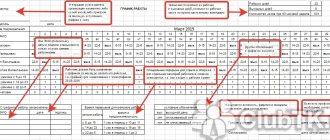What is a shift schedule
To finally understand what a 2/2 work schedule is, you need to understand what a shift work schedule is. To put it simply, such a work schedule allows you to organize the uninterrupted operation of the enterprise. To organize such a schedule, it is necessary to form 3 teams of workers. Such an organization of work is provided for and clearly regulated by labor legislation, while the employer is obliged to include a clause on the corresponding procedure in the employment contract. It is worth noting that working days and weekends in such a schedule will not be the same and will differ from week to week.
Which enterprises need such a regime?
Such organizations include:
- Transport sector, airport and railway.
- Gas stations (shift schedule allows you to avoid loss of revenue, because gasoline is in demand at any time of the day).
- Emergency services (police, ambulance, fire and other services).
- Continuous cycle production plants. These include large industrial facilities whose activities cannot be stopped. Otherwise, the company loses time, as well as a lot of money in connection with the new launch of equipment.
Work 2 through 2
Today there are various options for shift work schedules. The most common work schedule is 2 through 2. This schedule involves working 2 days in a row, followed by 2 days off. Often, with such a work schedule, the work shift lasts not 8 as usual, but 12 hours, while in 7 days, the weekend is not 2 as usual, but 3 days. It is also worth noting that you will have to go to work both on weekdays and on weekends, and on public holidays, if a shift falls on them. And most importantly, even if the shift falls on a weekend or holiday, the shift is paid at the standard rate.
How to write it in the agreement?
In the first paragraph of the employment contract, “Working hours and rest hours,” it is necessary to state that the employee will perform his job duties on a shift basis. We talked about how to correctly display working hours in a TD in this material.
Next, the document specifies the name of the schedule according to which the employee will work in the organization.
Then the number of working hours per shift is recorded. Other clauses in the contract are standard, namely:
- Rights and obligations of the parties.
- Details of the parties (personal data of the employee and information of the employer organization).
- Salary amount.
- Subject of the contract (employee position).
- Working conditions.
- Job responsibilities.
- Validity.
We talked in more detail about the terms and content of the employment contract, as well as what points should be reflected in it here.
The wording may look like this: the employee performs his duties in shift mode. Work is carried out according to a schedule called “Maintenance”.
Who works shifts?
A shift schedule is often used for organizations that require constant round-the-clock work. Most often these are organizations:
- Emergency services. Fire brigade, police, ambulance, rescue services, emergency services. As well as any other organizations that require assistance 24/7.
- Large industrial enterprises where production cannot be stopped. The equipment in such production works without stopping for several years.
- Services sector. Hotels, restaurants, catering establishments, security services.
- Transport sector. First of all, airports and train stations, where downtime is not allowed.
- Trade. There are large hypermarkets, or convenience stores, and gas stations that operate around the clock.
Many organizations work on a shift schedule; the main thing is to adhere to labor laws. It is also worth considering that with a shift schedule, the number of working hours is increased; this is usually associated with stress on the body. Therefore, it is necessary to alternate night and day shifts, as well as take care of your health. But in general, this regime also has positive aspects, for example, a sliding schedule allows you to rest both on weekends and on weekdays, and is also guaranteed to have 3 days off a week. Therefore, everyone can earn effectively while working shifts.
Shift schedules: we make them according to samples
A shift schedule is a document that approves the duration and frequency of shift rotation. It is not normatively approved, it is drawn up in any form - and therefore often raises questions from personnel officers. As an example, let's look at the watchmen's shift calendar (several options) and tell you how to implement it at an enterprise. ConsultantPlus TRY FREE Get access
Shift work requires more detailed recording of working time. To eliminate overtime, a shift schedule or calendar is drawn up: art. 103 of the Labor Code of the Russian Federation says it is impossible to oblige an employee to work two shifts in a row. In order to improve the efficiency of operations or the use of equipment, it is recommended to take the following measures:
- increase the duration of the production process;
- divide workers into groups;
- distribute them among shifts;
- a month before the introduction of such an operating mode, familiarize them with the schedule.
The latter will be an addition to the collective agreement.
Advantages and disadvantages
The advantages of shift work include the following:
- the ability to choose daytime or night time - if you decide on some business during the day and simply don’t like to work in the first half of the day, then you can choose the evening or night shift;
- in some organizations they allow you to change shifts with colleagues without approval from your superiors - you will be able to free up the required period of time;
- the opportunity to work on a 2/2 shift schedule is like a chance for part-time work if at other times you are busy with study or other work.
There are also disadvantages:
- Most organizations with a shift schedule provide for difficult working conditions. For example, office work is never organized in shifts - everyone works during the day. But cashiers, security guards, and production workers are forced to work at night;
- It’s not always possible to choose the right time to work on your own. Sometimes your shift falls overnight, even if you don't want it. If you are not on the list of people who work at night only with their written consent, then you will not be able to change the schedule;
- violation of the regime - constant night work will disrupt the sleep pattern, and by the morning the body’s performance will decrease.
How to create a shift schedule
There is no legally established form for such a report card, so each organization develops it independently. In the document please indicate:
- distribution of working days and days off during the week;
- number of shifts per day;
- duration, start and end times;
- start and end times of lunch breaks.
After drawing up, the document is approved by the head of the organization with his personal signature and seal (if any). At the bottom there is a place for the signatures of shift workers about their familiarization at least a month before its implementation.
The finished document looks like this:
In other words, the shift schedule is how many hours and at what frequency each person works per month. If necessary, indicate non-standard working days for each employee.
Payment
Due to the fact that working hours during a shift schedule are recorded over long periods, usually a month, payment is calculated based on the number of shifts worked during this period.
The accounting period is the period of time for which shift work is established. It is based on existing standards within the framework of labor protection.
A schedule is drawn up in such a way that each of the organization’s employees has the opportunity to work the required number of hours. In addition, it takes into account the planned annual vacations of employees.
The average working month is 167 hours. If overtime work occurs, it is paid additionally. In cases where an employee does not have time to work the required hours, payment for them is deducted.
When working on weekends and holidays, an increase in wages is not provided due to the nature of such a schedule.
Features of working at night
It is prohibited to work on the night shift:
- under 18 years of age;
- pregnant women.
Women with children under 3 years of age, disabled people, single parents, and those caring for the sick can work at night (only with written consent).
Labor Code of the Russian Federation in Art. 154 determines the mandatory use of increased coefficients in relation to hours worked by an employee at night. The minimum amount is 20%. The maximum amount of additional payment and its determination is the right of the manager.
In general, Decree of the Government of the Russian Federation dated July 22, 2008 No. 554 establishes the same minimum amount of extra pay for night work for all employees, or rather a 20 percent extra pay for each working hour.
The specific amount of the increase in payment for going out at night is established:
- collective or labor agreement;
- local regulations.
The additional payment is calculated from the hourly tariff rate (salary per hour of work), that is, when establishing an additional payment for work at night, other additional payments and (or) allowances should not be taken into account.
Features of shift work
Features of labor processes influence the established regime. However, in any case, it must be carried out in compliance with the conditions established by current legislation.
The schedule can be entered in relation to different time periods. Using summarized accounting, the employer establishes an accounting period.
The replacement format is introduced for a specified period or on an ongoing basis. The main thing is to determine the employee’s working time, which is not higher than the established duration for such a category. This means that neither overtime nor overtime is included in the plan (they are entered in the time sheet). It is important to consider that adequate rest must be provided during a 12-hour shift.
It is imperative to follow the provisions of Art. 94 of the Labor Code of the Russian Federation and take into account the employee’s membership in those groups for which a special work shift duration is determined, including a reduced duration.
The duration of the shift varies, depending on the needs of the organization. However, days off must be provided exactly according to the work plan. Working under shift conditions does not deprive the right to annual leave and paid sick leave.
The Labor Code of the Russian Federation does not establish the duration of the period for which a shift regime is drawn up. As a rule, this is one month, but the shift can last for a year.
Night shift
A night shift is a shift, most of which occurs at night. The time preceding it is called the evening shift. Their duration is a total of 16 hours. But in most cases, a 12-hour work shift is assumed, when the organization works 24 hours.
Usually the working day begins and ends at 8 o'clock in the morning or evening, respectively. At the same time, the employee does not have the right to independently change the existing schedule without agreement with the administration. You can only work on your own shift.
It is important to ensure an even rotation of established teams: each of them should alternately work day and night shifts.
There are several options for organizing work. Typically, workers go first during the day, then into the evening or immediately into the night shift. But it is possible to work in a couple of shifts - two days a day, then two days a night.
Labor standards rules for shift work
The shift schedule according to the labor code requires the preparation of acts that include the following information:
- Weekly duration. The schedule can be flexible, including the exact number of shifts.
- Duration throughout the day. The total number of shifts at the enterprise is also established. One to four shifts are allowed for specialists working at different times.
- Breaks, start and end of shift. The order of alternating not only working days, but also weekends.
It is recommended to use current methods developed for the HR department. This allows not only to ensure full production capacity, but also not to violate the rights of workers. At the same time, the correctness of documentation and the normal passage of inspections by the labor inspectorate are guaranteed.
Working time tracking and payroll calculation
The management of the enterprise can choose one of the following options for recording hours worked:
- Daily. The daily work always remains the same. All other periods are considered overtime and are paid.
- Weekly. The accounting period is a week, and daily work and shifts are set by a schedule. Hours worked are counted daily, but you can only talk about working out the norm or overtime after the end of the week.
- Summarized. This method involves the use of different accounting periods - month, quarter, etc. Such recording of working time is usually decided upon by institutions that have a special nature of work. During a certain day, shift or week, a subordinate may be subject to overtime, but at the end of the accounting period, the employer is obliged to either resolve the situation or financially compensate for the overtime.
It is not difficult to calculate and pay wages to an employee; you just need to multiply the rate by the number of hours worked (T).
RFP = Rate * T
All difficulties occur at the end of the accounting period, because at this point it is necessary to determine: the duration of duties performed beyond the norm, working hours that fall on weekends and holidays, days of rest due to donating blood, etc.
The variety and number of such moments will not allow the accountant to relax. It will be necessary to re-read the norms set out in the Labor Code more than once, because non-compliance can result in considerable fines for the manager.
Night shift
In the Labor Code, namely in Art.
154, the condition for the application of increasing coefficients in relation to hours falling at night is fixed. Determining the level of the maximum additional payment is the prerogative of the head of the enterprise, but it cannot be less than 20%, since this is the value guaranteed by current legislation.
The following factors may influence the amount of pay for night hours:
- the minimum value of the surcharge, determined and approved at the legislative level;
- the bonus coefficient established by an internal local act of the organization, that is, directly dependent on the will of the manager;
- The duration of job duties at night is from 22:00 to 06:00.
Holiday salary bonuses and overtime
To pay for overtime, you need to determine the number of hours worked in excess of the norm.
The weekly method is the simplest - from the total number of hours spent at the workplace, you need to subtract the standard amount of working time for a given accounting period.
If the management of the organization has settled on summarized accounting, then payment for processing must be made when the reporting period ends. For example, if an annual period of time was adopted, then all hours actually worked during this time should be summed up and standard hours should be subtracted from them.
In accordance with Art. 152 of the Labor Code of the Russian Federation, the employee is entitled to the following material compensation for overtime:
- one and a half rate - for the first 2 hours;
- double - for the rest of the time.
The above coefficients are approved at the legislative level; accordingly, they are the minimum requirements - each employer has the right to increase the indicators.
According to Art. 153 of the Labor Code of the Russian Federation, if a citizen had to spend non-working holiday time at work, then he is entitled to double pay. This value is also minimal and can be increased by adopting an internal local act.
With a different schedule, if a subordinate expresses a desire, the employer can offer him to compensate for his work time on a holiday by providing an additional day off, but with a shift work schedule this cannot be done.
A shift that falls on a non-working holiday can only be compensated financially. And if a subordinate goes to work beyond his own norm, then he can independently decide what he needs more - money or rest.










